
After undergoing a transformative hair transplant procedure, the post-operative care plays a crucial role in ensuring optimal results. One significant step in this process is the removal of the bandages.
At Civas Hair Transplant, bandages are removed within 24 to 48 hours after the hair transplant surgery. The specific timing may vary based on the surgeon's recommendations and the type of procedure performed.
The removal process is usually quick and painless. A healthcare professional will gently unwrap the bandages, ensuring minimal disturbance to the transplanted grafts. As the bandages are removed, the medical team will carefully inspect both the donor and recipient areas. This step is crucial in assessing the initial success of the transplantation and ensuring there are no signs of infection.
It's common to experience mild swelling and redness after bandage removal. This is a natural part of the healing process and typically subsides within a few days.
Once the bandages are removed, the next crucial step in your post-hair transplant care routine is the first hair wash. Proper cleansing is essential to promote healing, maintain scalp health, and ensure the longevity of your newly transplanted hair.
Steps for the first hair wash after a hair transplant procedure:
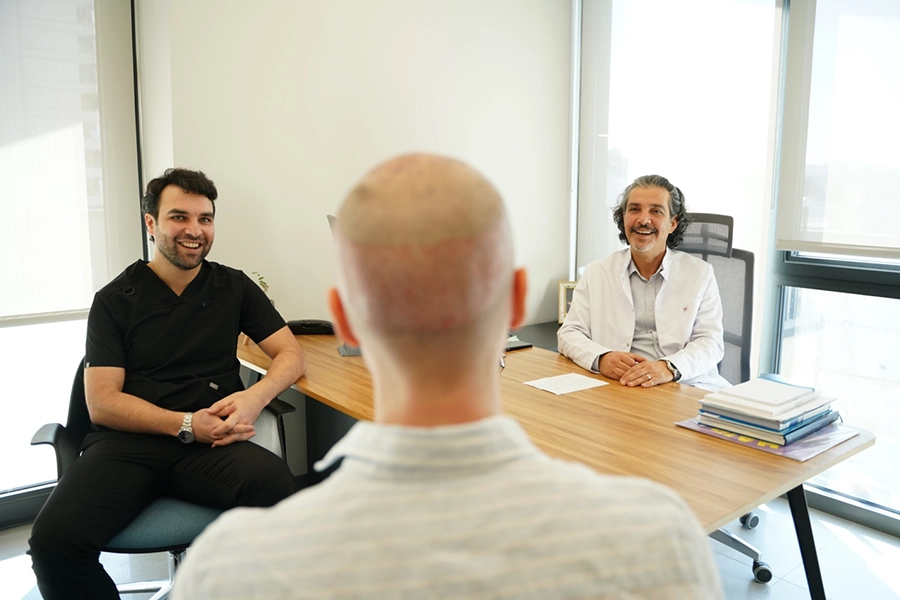
At Civas Hair Transplant in Turkey, our commitment to your well-being extends beyond the surgical procedure. A post-operative consultation with our experienced doctors, Dr. Civas and Dr. Akpınar, is a pivotal step in ensuring that your recovery is on track and addressing any questions or concerns you may have.
The consultation on the day of bandage removal and first hair wash allows our medical team to assess the immediate progress of your hair transplant. This includes evaluating the condition of the transplanted grafts, checking for any signs of infection, and ensuring that the healing process is underway as expected. If you have any concerns or questions about your recovery, this is the ideal time to discuss them with our doctors. Based on your specific case and progress, our doctors will offer personalized recommendations for ongoing care. This may include adjustments to your hair care routine, suggestions for managing any temporary side effects, and guidance on when to resume regular activities.
Rest assured that your patient coordinator is committed to supporting you throughout your healing process. They will stay in regular communication with you to ensure that everything is progressing smoothly and address any concerns or questions you may have. To facilitate this ongoing support, we kindly request that you share pictures of the front, back, and sides of your head every month. This allows us to closely monitor your progress and make any necessary adjustments to ensure the best possible outcome. Your well-being is our top priority, and we appreciate your cooperation in keeping us informed about your healing journey. If at any point you have additional questions or need further assistance, your patient coordinator is here to provide the guidance and support you need.
The journey to regaining your natural hair is a significant investment, and the aftercare process is crucial for optimal results. In this comprehensive guide compiled by the doctors at Civas Hair Transplant, we'll walk you through the essential steps, from bandage removal to long-term maintenance, ensuring a smooth and successful recovery.
Here's a comprehensive list of post-operative guidelines to follow during the crucial first 10 days after your hair transplant procedure:
Here's a comprehensive list of post-operative guidelines to follow and precautions to take during the first month after your hair transplant:
Undergoing a hair transplant is a significant decision that goes beyond just restoring hair; it's a journey towards rediscovering confidence and embracing a positive change in self-perception.
At Civas Hair Transplant, we understand the significance of this journey and are committed to providing not only exceptional surgical expertise but also comprehensive support throughout the recovery process. Our goal is to ensure that you not only regain your natural hair but also experience a positive impact on your overall well-being and self-esteem.
From the initial days after the procedure, marked by bandage removal and mild discomfort, to the subsequent weeks with the formation of scabs and the shedding of transplanted hair, we'll guide you through each phase. As the journey progresses, we'll delve into the emergence of new growth, the nuances of the first month, and the ongoing monitoring of your progress in the months to come.
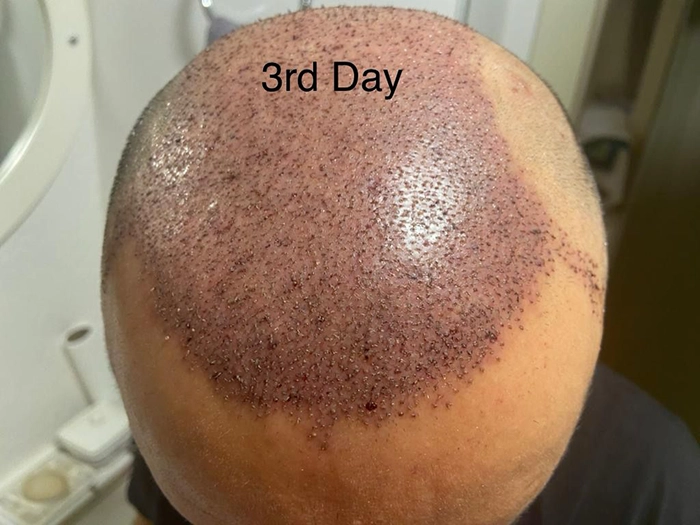
In the first week following a hair transplant, it's not uncommon for patients to experience some bleeding, soreness in the donor area, tightness of the scalp, and numbness in the transplanted region. Swelling is a natural occurrence, especially around the forehead and eyes, peaking within the first 5 days. As the initial week progresses, scabs begin to form around the transplanted grafts, serving as a protective layer. Around the 7th day, these scabs naturally start to detach, signifying the commencement of the healing process.
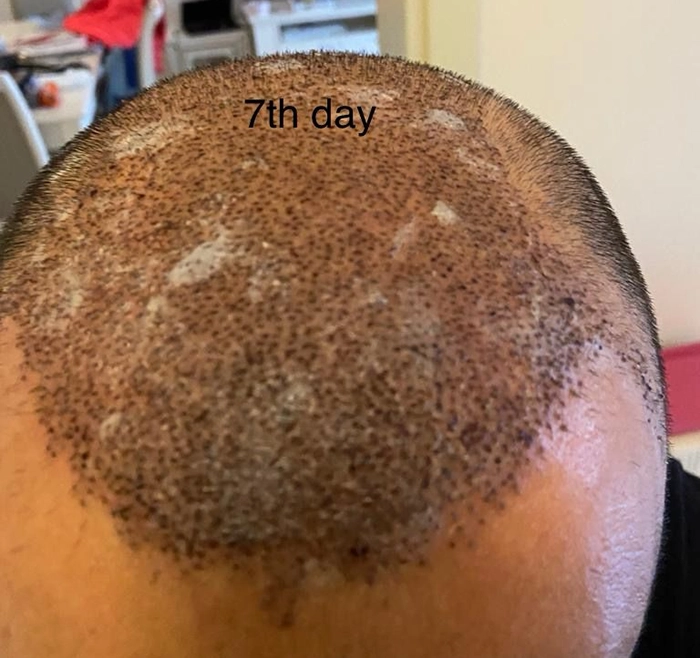
During the second and third weeks post-hair transplant, the scalp undergoes a crucial phase of healing. As scabs naturally fall off, the scalp's surface continues to recover, revealing the positive progress beneath. While transplanted follicles are now permanently in place, it's common for the transplanted hairs to become detached and start shedding off. This shedding is a natural part of the process, making way for new, resilient hair growth. Patients may experience some discomfort during this period, including pain in the donor area and an uncomfortable itchiness as the nerves heal. To alleviate these symptoms, we provide specialized medication, ensuring that you are well-supported and comfortable throughout this transitional stage of your recovery journey.
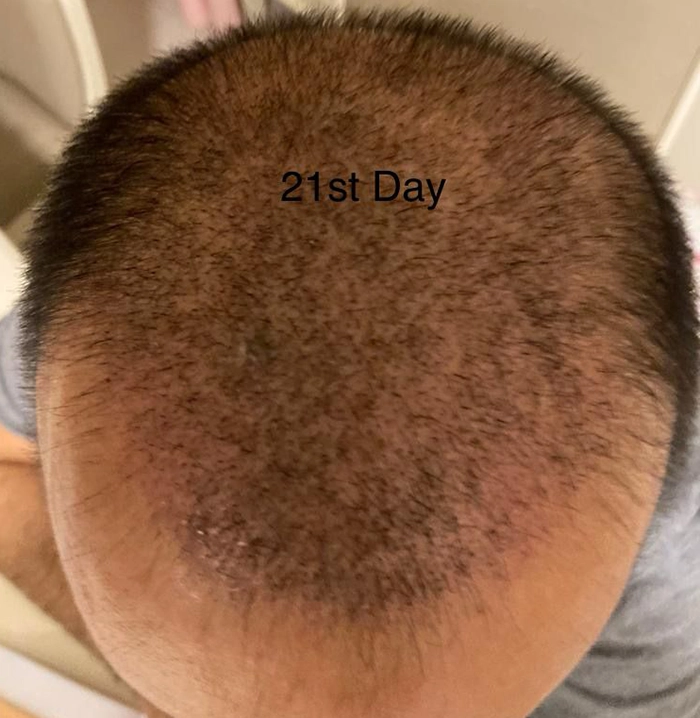
Between the first and second months after a hair transplant, patients often encounter a phenomenon known as "shock loss." During this period, the transplanted hair sheds, which might be disconcerting for some. Additionally, some patients may notice patchy hair loss in areas that were not part of the transplantation process. While this might initially cause concern, it's important to understand that it is a normal part of the recovery process. The follicles enter a temporary resting phase, resulting in a pause in new hair growth. This phase is pivotal for the follicles to prepare for the upcoming growth cycle. Although the visible effects of redness persist during this period, rest assured that it gradually fades, marking another positive stride in your recovery journey.
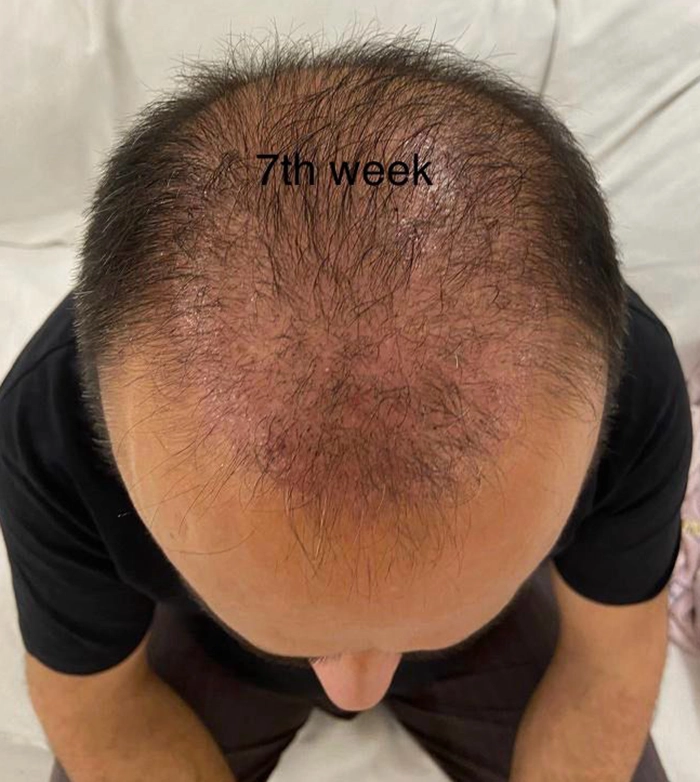
Between the second and third months post-hair transplant, a promising development occurs as fine hair begins to sprout. This subtle growth is an encouraging sign of the underlying progress taking place beneath the surface of the scalp. However, along with this positive transformation, patients may observe the occurrence of pimples, often associated with ingrown hairs. The emergence of ingrown hair pimples is a common occurrence as the new hair begins to surface. While this may raise concerns, it is a transient phase that can be managed with proper care and the provided medication. Over this period, you'll notice a gradual fading of redness, marking a continued improvement in the overall appearance of the treated area.
As you progress into the 4-6 month mark post-hair transplant, exciting transformations become increasingly apparent. Most patients undergo varying levels of hair growth during this period, signifying the efficacy of the procedure. By the 4-month milestone, a discernible improvement in density and patchy hair growth is often observed. The hairline begins to take shape, contributing to an enhanced overall appearance. Continuing through the 6-month period, a substantial leap forward is seen, with approximately 60% of the transplanted hairs now fully grown. This stage marks a significant improvement in coverage, density, length, and thickness, bringing you closer to the desired final outcome.
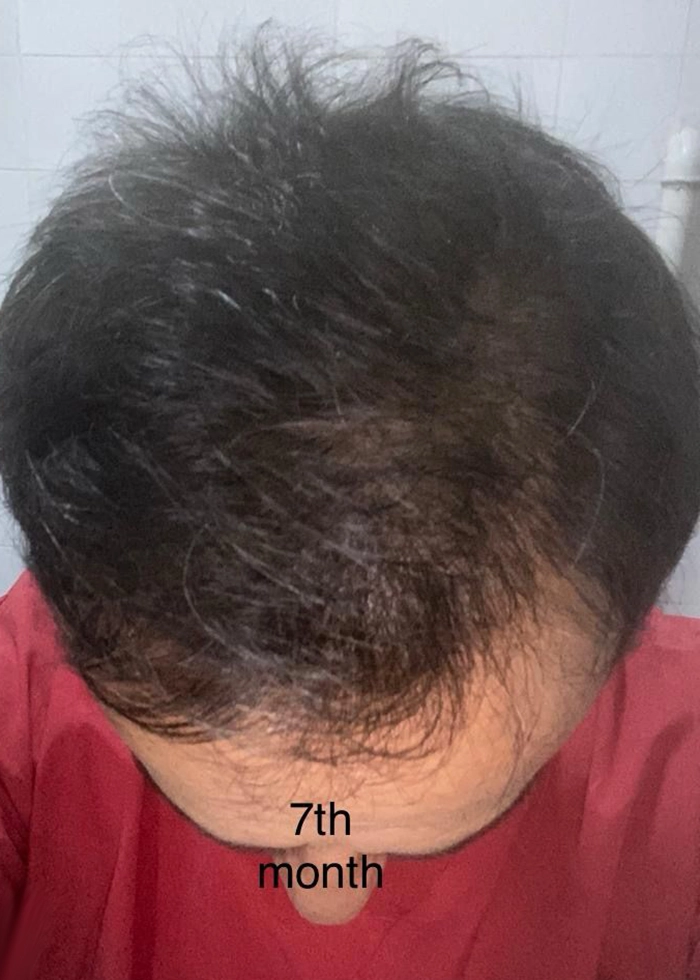
Between the 7th and 10th months post-hair transplant, patients begin to witness a substantial transformation, with results ranging from 70% to 90% of the final outcome. This period marks a significant milestone, allowing individuals to explore diverse hairstyles and fully embrace the newfound versatility of their transplanted hair. At this stage, a consultation is recommended to review the before-and-after results, ensuring that expectations align with the achieved outcome. It's important to recognize that individual responses may vary, and personalized discussions with your medical team contribute to a comprehensive understanding of your unique progress. It's not uncommon for some patients to observe temporary hair shedding during this timeframe. This occurrence is often associated with transplanted hair entering a resting phase (telogen). If you notice such shedding, there's no need for concern, as this is a normal part of the hair growth cycle. The transplanted hair will regrow within approximately two months, contributing to the continued enhancement of your final result.
Reaching the 1-year mark post-hair transplant marks the culmination of your transformative journey. At this stage, patients typically witness the full realization of their desired results, with hair that is not only fully grown but also exhibits a normal texture, thickness, and density. The meticulous planning, advanced techniques, and comprehensive care throughout the process converge to deliver a natural-looking and satisfying outcome. Your hair has undergone a remarkable journey of growth and transformation, reflecting the success of the transplant procedure. The once-implanted follicles have fully acclimated, resulting in a flourishing and seamlessly integrated head of hair. This final stage signifies not only the completion of your recovery but also the beginning of a new chapter, marked by confidence, self-assurance, and the enduring joy of a revitalized appearance.
Note: In all these growth stages, the patient is advised to send us his/her photos to monitor their progress.
The normal recovery time after a hair transplant varies depending on the individual and the complexity of the procedure. Generally, patients can expect the initial healing process to occur within the first two weeks, during which they may experience mild discomfort, swelling, and scab formation. However, it's crucial to note that visible results take time to manifest, with initial signs of new hair growth often appearing around the third to fourth month. Patience is key during this transformative journey, as the complete realization of results typically takes around one year.
After a hair transplant, it's generally advised to avoid wearing tight or restrictive headgear for the first few days to allow the transplanted area to heal without unnecessary pressure. However, once the initial healing period has passed, usually within a week, you can safely wear a loose-fitting hat or cover your head with a scarf to protect it from the sun or environmental factors. It's important to choose headwear made from breathable materials to avoid trapping heat and moisture, which could potentially irritate the healing scalp and to ensure that your chosen headwear doesn't interfere with the healing process and supports the long-term success of your hair transplant.
In the immediate aftermath of a hair transplant, it's advisable to refrain from engaging in strenuous exercise and activities that may lead to increased blood flow or sweating for at least the first week. Strenuous activities could potentially disrupt the healing process and may cause unnecessary stress on the transplanted area. After the initial week, gradually reintroduce mild exercises, and by the end of the second week, most patients can resume their regular exercise routines. However, it's crucial to listen to your body and avoid activities that cause discomfort or strain.
Shock loss is a temporary condition that some patients may experience after a hair transplant. This phenomenon occurs when the existing hair in the recipient area undergoes a shedding phase due to the trauma of the transplantation process. It's essential to recognize that this is a normal part of the hair growth cycle, and it is not a sign of the failure of the transplant. Typically, shock loss occurs a few weeks to a couple of months after the procedure, and the shedding is temporary. The transplanted follicles remain in place, and new hair growth begins after a brief resting phase.
Yes, it is entirely normal to experience shedding of transplanted hair in the weeks following the procedure. This phase, known as shock loss, is a natural part of the hair growth cycle and can be somewhat disconcerting for patients. The transplanted hair goes through a temporary shedding period as it adjusts to the new environment. However, it's important to note that this shedding is not indicative of the failure of the transplant.
The timeline for transplanted hair growth varies from person to person, but in general, initial signs of growth can be observed around the third to fourth month after the hair transplant procedure. This marks the beginning of a transformative phase as fine hairs start to emerge from the transplanted follicles. However, visible improvements in density and coverage become more apparent between the sixth and twelfth months post-surgery. By the sixth month, about 60% of the transplanted hairs are typically grown, leading to a substantial enhancement in the overall appearance. Patience is essential during this process, as the final and complete results may take up to one year or longer to fully manifest.
The final results of a hair transplant typically become noticeable approximately one year after the procedure. While initial signs of growth may be observed around the third to fourth month, the complete realization of outcomes, with hair fully grown, normal in texture, thickness, and density, becomes evident by the one-year mark. It's essential to understand that the process is gradual, and individual responses may vary. Patience during this transformative journey is key, and regular follow-up appointments with your medical team will provide insights into your unique progress, ensuring that expectations align with the unfolding and permanent results of the hair transplant.